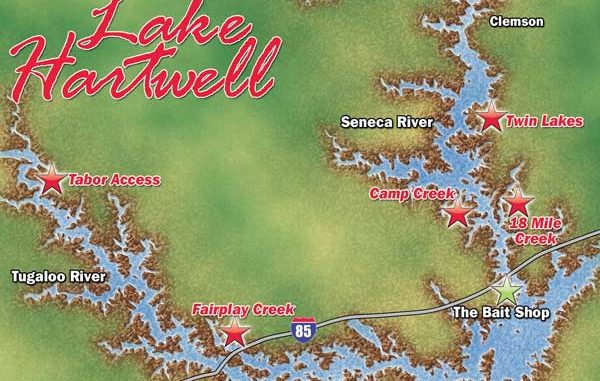
Around the corner from Death Valley, Lake Hartwell sports another growing trophy fishery — one with whiskers.
It would come as no surprise to be in the area of Lake Hartwell close to Clemson University and strike up a conversation about big cats.
A lot of them live up there. They’re decked out in orange and purple, and they run down the hill and play football in Death Valley.
However, there is another, lesser-known big cat on the other side of the hill from the stadium, out in the lake. This one is blue, it swims, and it’s the one Capt. Bill Plumley prefers to face on Saturdays.
“I had a place on the (Diversion) canal at Santee for years, and I’ve always loved to catfish,” said Plumley, a fishing guide on Lake Hartwell. “Santee has been known for a long time for trophy blue catfish, but I didn’t realize they were here in Hartwell until I caught one four or five years ago by accident while fishing for channel catfish. Since then, I’ve caught numbers of them in the 20-pound range and one that weighed over 35 pounds, and I’ve seen bigger ones caught by some of the other striper guides that would go 40 to 50 pounds.”
That Hartwell supports blue catfish in those size ranges prompts the question of how they came to call the 56,000-acre Savannah River lake, nearly 200 miles west of Santee Cooper, home.
“Blue catfish are hard to electroshock, so we missed them for several years in our electro-fishing surveys,” said Dan Rankin, an S.C. Department of Natural Resources fisheries biologist whose office is in Clemson. “Our last Hartwell catfish angler surveys were done in 1992, and I don’t think there were many in the lake at that time. Hartwell’s only native catfish species are white catfish and a couple of variations of the bullhead species that were in the rivers when the lake was impounded. Neither of them grow very large.
“Since the lake was impounded, we have discovered channels, blues and flatheads, but these fish were not stocked by the DNR. These stockings were most likely done by anglers transporting fish from other lakes or by fish that were put in private ponds somewhere in the Hartwell drainage area and have found their way into the lake by swimming downstream.”
According to Scott Lamprecht an SCDNR fisheries biologist based in the Santee Cooper area, blue catfish were introduced into Lake Marion and Lake Moultrie in 1964 when striped bass brood stock were traded to Arkansas in exchange for 300 blue catfish.
“After they were established here, we’ve had reports of them showing up in other lakes — Wateree, Wylie, and all of the Savannah chain lakes,” Lamprecht said. “It’s not hard to transport a fish that can still survive after being in a bucket of water or cooler full of ice for six hours.”
Regardless of how they got into Hartwell, the lake offers plenty of forage and space for the big cats to flourish. Few fishermen target blues at Hartwell, and Plumley believes he’s the only guide who offers trips that target them.
“Blue cats like cooler water; the cooler it gets, the shallower you’ll find them throughout the winter,” he said. “On a typical day in November, it’s not unusual to catch eight to 10 blue cats in the 5- to 12-pound range, plus whatever channel cats you pick up. Hartwell is full of nice, eating-size channel cats, but they start to slow down once the water gets down around 60 degrees in the fall.”
Although his trips for stripers greatly outnumber the number of requests he gets for catfish, when he does target them, Plumley has a pretty air-tight pattern for finding them.
“Another misconception about blue cats is that they lay on the bottom and don’t move,” Plumley said. “Actually, they move around a lot. They may be in the back of a creek at daylight, and by mid-day, they’ll move all the way out to the main river channel. I have caught blues all over the lake at one time or another, but during the fall, I’ll follow a similar pattern and fish back in a creek at daylight, and then move to deeper water after the sun gets up.”
Plumley focuses his efforts in two areas: the stretch of the Tugaloo River from the I-85 bridge near Fairplay all the way up to the Hwy 123 bridge above Westminster, and the entire stretch of the Seneca river arm.
Plumley said he catches the majority of his fish during November in water between 20 and 60 feet deep. He may fish shallower if he locates concentrations of baitfish closer to the bank, which is typical for early in the morning. Likewise, he wants to graph a large school of baitfish before he decides to commit to any one area.
“Striper and catfish arches on the graph give different signals,” he said. “The popular belief is that stripers give a harder signal because they have scales and catfish don’t. Either way, I’m going to anchor the boat front and back and give it a shot if I see baitfish and large arches in the right location.”
The “right location” may be the edge of a channel up one of the main rivers, a deep flat adjacent to a main channel, or a long point that drops off into deeper water. Long points often serve double duty if he can beach his boat and reach the deeper water with a long cast.
Once his boat is secure, Plumley fan casts six to eight rods in a semi-circle off the transom of his 23-foot center console. His boat is set up with a homemade trolling bar that allows him easy access to the rods. In addition, the bar is outfitted with Driftmaster rod holders that allow the rods to angle up for fan-cast fishing or parallel to the water for vertical fishing.
“My rod-and-reel setups are Ambassadeur baitcast reels on Berkley Glowstick rods,” he said. “My line is standard Berkley Big Game in 20-pound test. I’ll go to 30 if I know I’m going to be fishing around structure; there’s a lot of timber and stumps up some of these creeks. I use a Carolina rig with a 2-ounce flat sinker to keep wind or waves from washing the bait. One tip for creating a good cut-bait rig is to match the size of the hook with the size bait you’re using. My hooks range from a 5/0 to a 10/0-standard Eagle Claw J-type hook “
Plumley’s choice of baits is dictated by water depths. In November, he usually fishes with fresh-cut blueback herring to “match the hatch” when he’s fishing deep water. He said that gizzard shad are typically not a deepwater bait, so he reserves big chunks of fresh-cut shad for cold-weather fishing when blues may be as shallow as three feet deep.
“They’ll roam the banks when it’s cold, looking for mussels or dying shad,” Plumley said. “I once caught a 25-pounder in early March in two feet of water on a big chunk of gizzard shad. But this time of year, the herring seem to work best.”
Plumley says blues don’t fool around and peck a bait to death like a channel cat or sneak off with a slow tick of the open-spool baitcast alarm like a flathead.
“When it’s a blue, especially a good one, he’ll grab it and go,” he said. “The line will go from a broad bow to the rod bent double and hurting. That’s a good blue cat bite!”


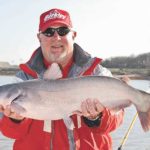
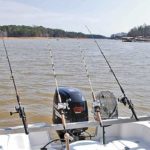
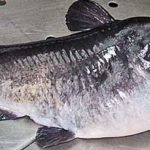
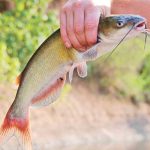
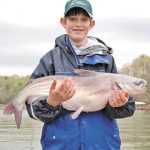
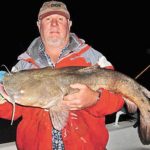
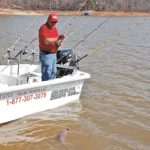



Be the first to comment